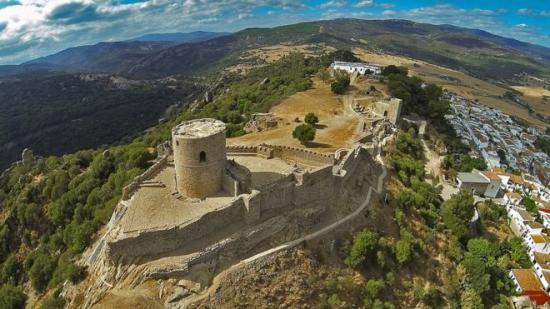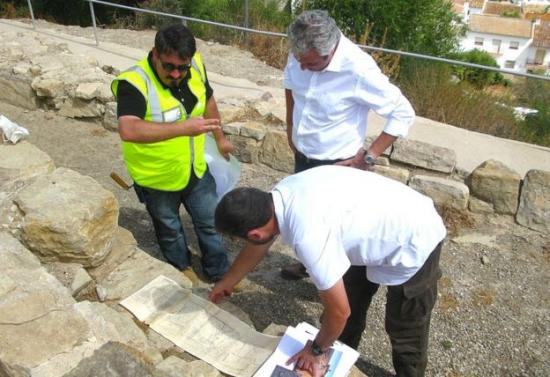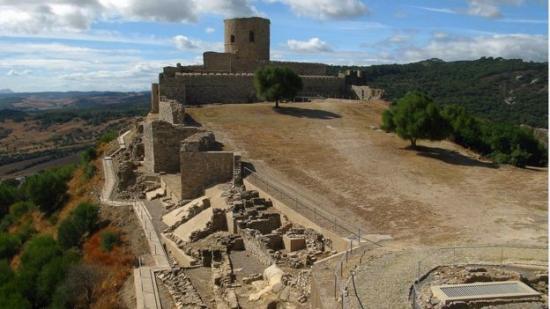Sylvia Smith
Source - http://www.bbc.co.uk/news/science-environment-34956067
 Archaeologists have begun uncovering the remains of what they think could be one of the most important Roman settlements in Spain, under the present-day town of Jimena de la Frontera.
Archaeologists have begun uncovering the remains of what they think could be one of the most important Roman settlements in Spain, under the present-day town of Jimena de la Frontera.
Three Spanish archaeologists stand at the top of what is known locally as the Moorish castle looking at detailed plans.
As well as showing the extent of their latest excavations, the drawings reveal that the hilltop town has some of the most significant and virtually untouched Roman remains in the region showing the town to have been a major settlement and shedding light on the power structure of the occupying force of the time.
The Castillo de Jimena de la Frontera is the original settlement of the current population of Jimena containing traces of an ancient and multi-cultural history, yet its existence lay hidden for many centuries until a retired archaeologist who used to walk up to the castle on a daily basis spotted signs of early Roman occupation.
According to Juan Miguel Pajuelo, the archaeologist who is co-ordinating the phases of the investigation, without the initial unpaid work carried out by Hamo Sassoon who retired to Jimena, the extraordinary Roman city could have still remained undiscovered.
"If it weren't for his acute observational powers - and powers of persuasion - it
is doubtful that we would have this opportunity to understand Oba, as Jimena was known between the first century BC and the third century AD," he says.
 Here, the University of Seville archaeologists examine drawings at the site of a Roman wall
Here, the University of Seville archaeologists examine drawings at the site of a Roman wall
Bilingual coins found on the site are proof of the existence of a Libyan-Phoenican settlement on the site with the name "OBA". After the conquest by Rome the name OBA was Latinised and converted into Res Publica Obensis, endowing it with the status of a town ruled by Latin law under the government of Emperor Vespasian.
This effectively converted it into a city ruled by a local senate with the appearance of magistrates such as the Duumviri and the aediles.
"At first sight the impression is of visiting an Arab castle, slightly altered in the 19th Century," says Miguel Angel Tabales, who has been in charge of the excavations since 2002 and is professor of archaeology at the University of Seville.
"But the moment you take a critical look and analyse what you are actually seeing you quickly realise that this is nothing other than the remains of a very important Roman city."
The initial Roman compound colonises a hill strategically located on the natural thoroughfare between the Serrania de Ronda and the Bay of Algeciras and has been occupied without interruption since the 8th Century BC.
 The plateau occupied by an imposing Moorish castle also hosts Roman remains
The plateau occupied by an imposing Moorish castle also hosts Roman remains
The remains of the Roman era are of particular interest since they include main doors, towers, hydraulic infrastructure adapted to the sloping nature of the site and a temple in addition to well-preserved walls.
Miguel Angel Tabales says that most of the perimeter wall of the urban fortification - partly Roman, partly Islamic - is conserved.
"By superimposing this enclave on to the usual structure of a Roman city, we can see that the public zone, the initial forum and the main street start in the lower part of the city," he explains. "This means the Romans adapted their original model to the topography of the site.
"The site was chosen because it gives commanding views of the surrounding countryside - an imperative for a military garrison. The monumental character of the architecture witnesses a time of great power and confidence. It added to Roman imperial propaganda," he concludes.
As well as the advantage of its geographic position, controlling inland routes from the Mediterranean coast from Gibraltar via Algeciras until reaching today's Ronda, Fancisco Reina Fernandez-Trujillo who is director of the restoration work believes there was another significant reason for its location.
"The enormous agricultural and livestock richness of the lush valleys of the two rivers - the Guardiario and Hozgargante make this a natural place to set up a sizable garrison town,." he tells the BBC.
 The remains of a Roman temple have also been excavated in Jimena
The remains of a Roman temple have also been excavated in Jimena
Major archaeological work on the complex site have enabled the initial phase of restoration of the compound's eastern sector over which the urban profile of modern Jimena is silhouetted.
The moving of the town from the western facade of the hill in the medieval era is what has allowed earlier remains to have survived virtually intact.
As well as a complex sequence of walls, excavations have brought to light the original Roman entrance to the enclosure. A path leads visitors up from the river, the most common mode of bringing supplies and troops from the coast, via a narrow road to be confronted by a large temple looming overhead and so emphasising the monumental nature of the place.
Although the same sense of grandiosity occurs during the Islamic period it is under much more modest parameters.
"The military character of Xemina, the Arabic name, was simply built upon the ruins of the Roman city. It was superimposed and is much more pragmatic," Miguel Angel Tabares explains.
"At a construction level, what we've found is little more than removing sediment and recycling Roman materials."
From 1059 onward Xemina was governed by the Taifa kingdom of Seville with cisterns, wells and accommodation witnessing the magnificence of the city under the Almohads, the Merenids and Nasrid powers.
But by 1431 Jimena had fallen into Christian hands only to be recaptured by the Muslims and then to be finally conquered by the Castilians in 1456 - a power struggle with shifting frontiers that added "de la Frontera" to modern Jimena as making the boundary between the two opposing forces.
So far, restoration works are still in their early days. The enhancement strategy complementing the restoration has so far been limited to making the restored compound accessible.
 The present-day town sits on a strategic route and has been inhabited continuously since the 8th Century BC
The present-day town sits on a strategic route and has been inhabited continuously since the 8th Century BC
But as the team from the University of Seville wait for the next phase of excavation to start there are growing concerns. The porous and slowly shifting substratum of the site poses problems. This instability made itself felt in earlier times and parts of the compound were reconstructed in response.
"This has preserved some walls on the interior in some of the lower sections but overall the movement of the land hasn't been favourable." says Francisco
Reina Fernandez-Trujillo. "The walls have adapted to those shifts, moving toward the interior and preserving the most ancient arrangements."
However, Miguel Angel Tabares warns that the problem of the site shifting on his hilltop position can only get worse.
"Without intervention parts of the site will deteriorate further and, without doubt, this will eventually lead to the disappearance of parts of the Roman construction," he says.
These worries are compounded by the site being unguarded and bounty hunters having free, unobserved access to the Castillo. The Mayor of Jimena de la Frontera, Pascual Collado Saraiva, has promised to bring in measures that will ensure the safety of the site.
"The castle is the identity of Jimena and we simply can't let it be plundered," he promises. "The route from the coast inland used by the Roman and Muslims invaders are part of our developing tourism strategy and will bring Jimena great benefit.